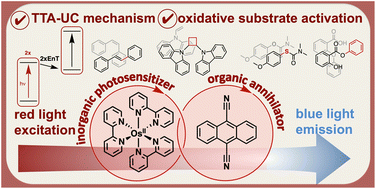Sensitizer-controlled photochemical reactivity via upconversion of red light†
Abstract
By combining the energy input from two red photons, chemical reactions that would normally require blue or ultraviolet irradiation become accessible. Key advantages of this biphotonic excitation strategy are that red light usually penetrates deeper into complex reaction mixtures and causes less photo-damage than direct illumination in the blue or ultraviolet. Here, we demonstrate that the primary light-absorber of a dual photocatalytic system comprised of a transition metal-based photosensitizer and an organic co-catalyst can completely alter the reaction outcome. Photochemical reductions are achieved with a copper(I) complex in the presence of a sacrificial electron donor, whereas oxidative substrate activation occurs with an osmium(II) photosensitizer. Based on time-resolved laser spectroscopy, this changeover in photochemical reactivity is due to different underlying biphotonic mechanisms. Following triplet energy transfer from the osmium(II) photosensitizer to 9,10-dicyanoanthracene (DCA) and subsequent triplet–triplet annihilation upconversion, the fluorescent singlet excited state of DCA triggers oxidative substrate activation, which initiates the cis to trans isomerization of an olefin, a [2 + 2] cycloaddition, an aryl ether to ester rearrangement, and a Newman–Kwart rearrangement. This oxidative substrate activation stands in contrast to the reactivity with a copper(I) photosensitizer, where photoinduced electron transfer generates the DCA radical anion, which upon further excitation triggers reductive dehalogenations and detosylations. Our study provides the proof-of-concept for controlling the outcome of a red-light driven biphotonic reaction by altering the photosensitizer, and this seems relevant in the greater context of tailoring photochemical reactivities.

- This article is part of the themed collection: Most popular 2023 physical and theoretical chemistry articles


 Please wait while we load your content...
Please wait while we load your content...